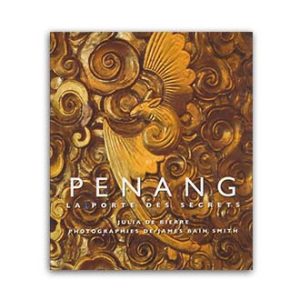By Marcus Langdon.
A little over two centuries ago, Penang became the fourth most important settlement – a presidency – of the British East India Company’s Indian territories. The fateful decision changed Penang’s future forever, reshaping it into a key player in the international trade network linking Europe with India and China. The first of a three-volume series, Penang: The Fourth Presidency of India presents an in-depth and compelling narrative of this fascinating period in history, focusing specifically on the role shipbuilding played, the leading political personalities, and two historic buildings that highlight the struggles, successes and failures of the early settlement. Illustrated with several never-before-seen paintings, engravings and maps, the volume and those to follow will be the authoritative reference for historians and general reader for generations to come.
Editorial Reviews
“This major study of the history of early Penang … is based on a decade-long examination of unpublished primary sources, notably the Straits Settlements Records in the British Library and a similar series in the National Archives in Singapore. … the book is unquestionably one of the most professionally conceived and well-written works published in an area of Malaysian history.”
John Bastin, Journal of the Malaysian Branch of the Royal Asiatic Society
“Much of the answer to one of my questions about Penang’s history can indeed be found in Langdon’s book, which makes me an immediate fan of his commendable project . . . Langdon has accomplished a book that no person interested in Penang’s past can do without. It is finely produced with an impressive array of illustrations, and is clearly one of the finest books on the first decades of the island’s history.” Ooi Kee Beng, The Penang Monthly
“Marcus Langdon is acknowledged as the leading authority on Penang’s early history under the East India Company…”
Carolyn O’Donnell, The Huffington Post
Langdon’s research has shifted Penang’s appeal from sensory to historical. With his newly-published book, he now passes this privilege on to his readers, allowing them access into the deeply engrossing and expansive history of the rise of Penang, the Fourth Presidency of India.
Kat Fatland, Penang International
“This monograph is extremely valuable. Marcus Langdon’s scrupulous use of relatively inaccessible, handwritten primary documents, undertaken with the passion of a committed researcher, is not likely to be replicated.” Loh Wei Leng, formerly University of Malaya.
About the Author
Born in England but transplanted to Australia early in life, Marcus Langdon is acknowledged as the leading authority on Penang’s early history under the East India Company. He has published in scholarly journals and his research findings have been widely cited by heritage advocates, architects, conservationists and local historian. He currently lives in Penang.
Table of Contents
(Linked excerpts of the book are marked in purple)
List of Maps and Illustrations
List of Abbreviations
Note to the Reader
Foreword by Geoff Wade
Preface
Acknowledgements
Introduction
Book One: Ships for a Presidency
– Introduction
– Early Deliberations
– Politics and Machinations
– The Bombay Dockyard
– Naval Command in Penang
– Presidency Minorities
– Engineering Matters
– Search for a Site
– Timber Supplies
– The Burma Establishment
– The Slipway Dispute
– Shipbuilding Begins
– Grand Plans on Hold
– One Last Hope
– Conclusion
Appendix: Equipment for Steam Engine and Pumps
Book Two: The Administrators
– Introduction
– Pre-Presidency, 1786-1805
– Captain Francis Light: Superintendent (1786-1789)
– Captain John Glass: Acting Superintendent (1789-1790)
– Captain Francis Light: Superintendent (1790-1794)
– Philip Manington: Superintendent (1794-1795)
– Thomas Pigou: Acting Superintendent (1795-1796)
– John Beanland: Acting Superintendent (1796)
– Major Forbes Ross MacDonald: Superintendent (1796-1797)
– George Caunter: Acting Superintendent (1797-1798)
– Major Forbes Ross MacDonald: Superintendent (1798)
– George Caunter: Acting Superintendent (1798-1800)
– Sir George Alexander William Leith: Lieutenant Governor (1800-1802)
– William Edward Phillips: Acting Lieutenant Governor (1802-1803)
– Sir George Alexander William Leith: Lieutenant Governor (1803-1804)
– Robert Townsend Farquhar: Lieutenant Governor (1804)
– William Edward Phillips: Acting Lieutenant Governor (1804-1805)
– Robert Townsend Farquhar: Lieutenant Governor (1805)
– Birth of a Presidency
– The Writers
– Philip Dundas: Governor (1805-1807)
– Henry Shepard Pearson: Acting Governor (1807)
– Colonel Norman Macalister: Acting Governor (1807-1810)
– Charles Andrew Bruce: Governor (1810)
– William Edward Phillips: Acting Governor (1810-1812)
– Archibald Seton: Governor (1811, 1812)
– William Edward Phillips: Acting Governor (1812)
– William Petrie: Governor (1812-1816)
– William Edward Phillips: Acting Governor (1816-1817)
– Colonel John Alexander Bannerman: Governor (1817-1819)
– William Edward Phillips: Governor (1819-1824)
– Robert Fullerton: Governor (1824-1830)
– Post Presidency
– Robert Ibbetson: Resident Commissioner and Governor (1830-1833)
– Kenneth Murchison: Governor (1833-1836)
– From Company to Crown
– Conclusion
Appendix: British Administrators of Penang and the Straits Settlements, 1786-1867
Book Three: Government House
– Introduction
– The Early Years
– A Change of Ownership
– The William Petrie Years
– Out with the Old, In with the New
Book Four: Suffolk House
– Introduction
– Contested Origins
– Social and Public Occasions
– The New Seat of Government
– A New Broom Sweeps In
– End of an Era
– Revival of Fortune
– Conclusion
Appendix: List of J. J. Erskine’s Furniture at Admiralty House, 1821
Conclusion
Bibliography
Index











Reviews
There are no reviews yet.